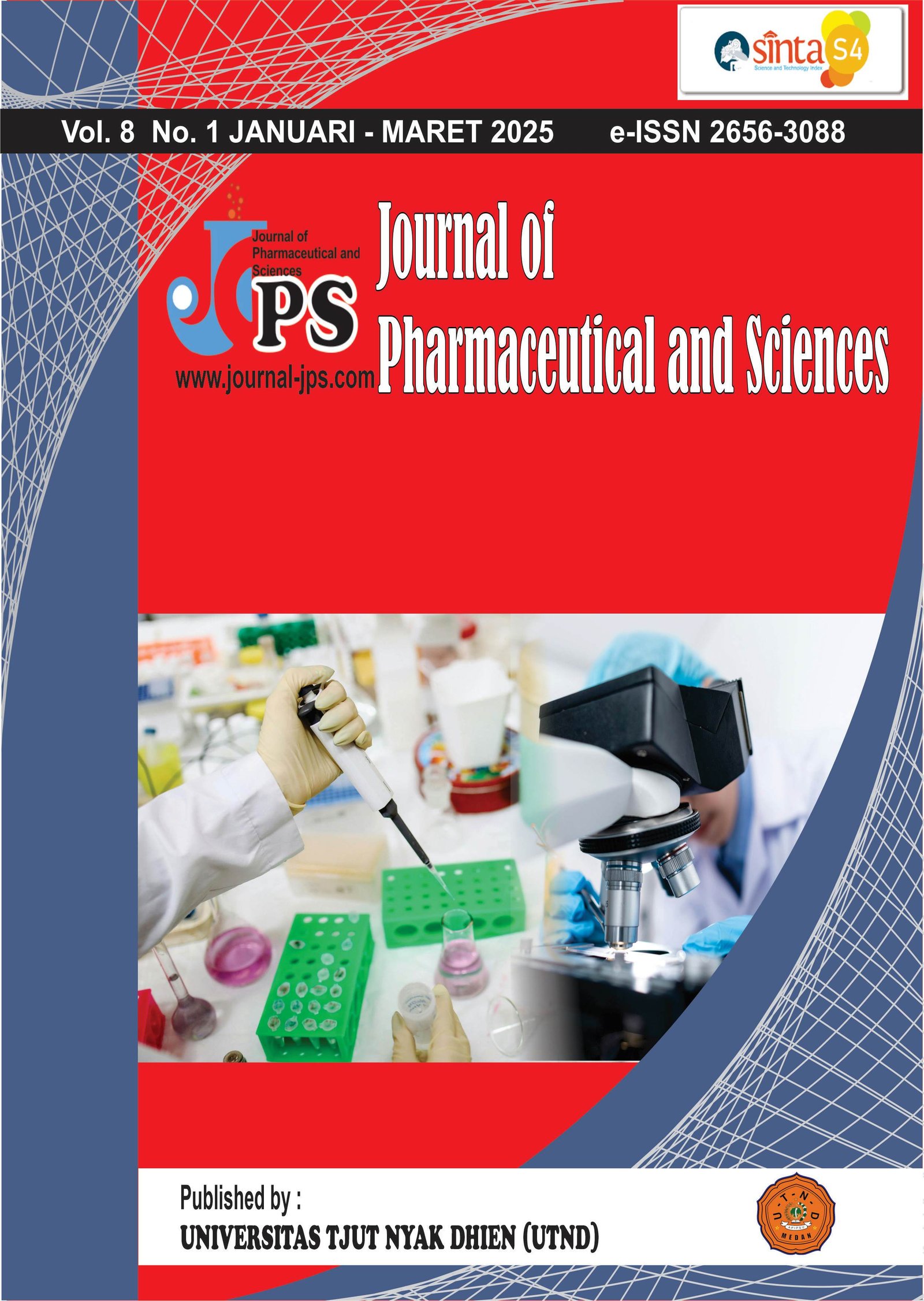The effectiveness of Gracilaria sp. ethanol extract spray preparation as a repellent against Aedes aegypti mosquitoes
Main Article Content
Page: 259-269
Abstract
Dengue Hemorrhagic Fever or commonly known as DHF is a disease that is transmitted through the bite of female Aedes aegypti mosquitoes which carry the Dengue virus so that it can cause Extraordinary Events (KLB). Prevention of dengue fever is generally carried out using refills containing the chemical DEET (N,N-diethyl-meta-toluamide) which is dangerous for the skin. Gracilaria sp. It is known to contain compounds that are toxic to mosquitoes, such as alkaloids, flavonoids, steroids, saponins, tannins and triterpenoids. This research aims to see the effectiveness of the ethanol extract of Gracilaria sp. as a repellent for Ae. aegypti, Effective Concentration 50% (EC50), irritating effects, and physical properties of the ethanol extract spray preparation of Gracilaria sp. The research was carried out with methodology in accordance with the recommendations of the World Health Organization Pesticides Evaluation (WHOPES) using a Completely Randomized Design (RAL). The protective power provided by the ethanol extract of Gracilaria sp. analyzed using Oneway ANOVA, followed by the Least Significant Difference (LSD) test. Probit analysis was carried out to determine the effectiveness of the ethanol extract concentration of Gracilaria sp. as a repellent. The research results show that concentration levels of 5%, 10%, 15%, and 20% provide protective power capabilities of 14.40%, 31.81%, 47.76%, and 61.17% respectively with an EC50 value of 18.86%. The spray is homogeneous and does not cause skin irritation. Conclusion, spray preparations containing ethanol extract of Gracilaria sp. potential as a repellent for Ae. aegypti. Using this repellent can help reduce the risk of dengue fever which is transmitted by mosquitoes. Further research is needed on the effectiveness of Gracilaria sp. as a repellent with a concentration above 20% and an irritation test was carried out on > 10 probands for > 15 minutes by spraying the preparation repeatedly.
Downloads
Article Details

This work is licensed under a Creative Commons Attribution-NonCommercial-ShareAlike 4.0 International License.
References
Mahendra YI, Syaniah AE, Astari R, Sy TZM, Aulia W. Analisis Penyebab Demam Berdarah Dengue (DBD) Desa Bandar Klippa Kecamatan Percut Sei Tuan. Jurnal Ilmiah Universitas Batanghari Jambi. 2022 Oct 31;22(3):1732. DOI: https://doi.org/10.33087/jiubj.v22i3.2790
Rokom. https://sehatnegeriku.kemkes.go.id/baca/rilis-media/20240616/0045767/waspada-dbd-di-musim-kemarau/. 2024. Waspada DBD di Musim Kemarau.
Tribratanews. https://tribratanews.lampung.polri.go.id/detail-post/semakin-melonjak-hingga-akhir-april-2024-wabah-dbd-di-lampung-capai-3-316#:~:text=Lampung%20%2D%20Dinas%20Kesehatan%20Provinsi%20Lampung,lonjakan%20kasus%20mencapai%203.316%20kasus. 2024. Semakin Melonjak, Hingga Akhir April 2024 Wabah DBD di Lampung Capai 3.316.
Katadi Z, Zaeni A, Suryani HR. Formulasi Losio Antinyamuk Dengan Zat Aktif Minyak Atsiri Lantana camara Linn. Jurnal Farmasi dan Ilmu Kefarmasian Indonesia. 2015 Jun;2(1):1–4.
Putri IHT, Marcellia S. Efektivitas Formulasi Spray Ekstrak Kulit Bawang Merah (Allium cepa L.) Sebagai Repellent Terhadap Nyamuk Aedes aegypti. Jurnal Ilmu Kedokteran dan Kesehatan. 2022;9(3): 934. Available from: http://ejurnalmalahayati.ac.id/index.php/kesehatan DOI: https://doi.org/10.33024/jikk.v9i3.7921
Meilina R, Dewi R, Husna A, Willis R. Formulasi dan Efektivitas Sediaan Spray Ekstrak Etanol Daun Mint (Mentha Piperita L.) Sebagai Anti Nyamuk Formulation and Effectiveness of Mint Leaves (Mentha Piperita L.) Ethanol Extract Spray as an Anti-Mosquito. Journal of Healtcare Technology and Medicine. 2024;10(1):89-96.
Soamole HH, Sanger G, Harikedua SD. Kandungan Fitokimia Ekstrak Etanol Rumput Laut Segar (Turbinaria sp., Gracilaria sp., dan Halimeda macroloba). Jurnal Media Teknologi Hasil Perikanan. 2018;6(3):287-291. DOI: https://doi.org/10.35800/mthp.6.3.2018.21259
De Geyter E, Geelen D, Smagghe G. First Results On The Insecticidal Action Of Saponins. Comm. Appl. Biol. Sci. 2007;72(3):645-648.
World Health Organization (WHOPES). Guidelines For Efficacy Testing Of Mosquito Repellents For Human Skin Control Of Neglected Tropical Diseases Who Pesticide Evaluation Scheme. Geneva: World Health Organization. 2009.
Harborne JB. Phytochemical Methods A Guide to Modern Techniques of Plant Analysis. Dordrecht: Springer Netherlands. Chapman and Hall. 1996. Available from: http://link.springer.com/10.1007/978-94-009-5921-7
Nayaka NMDMW, Suradnyana IGM, Vitaloka NPGDC. Evaluasi Mutu Fisik Dan Uji Iritasi Sediaan Spray Antinyamuk Dari Ekstrak Etanol Daun Legundi (Vitex trifolia L.). Majalah Farmasi dan Farmakologi. 2023;27(3):37-41. Available from: http://journal.unhas.ac.id/index.php/mff
Utami FD, Setianto AB, Yuliani S. Aktivitas Repellent Formulasi Sediaan Spray Kombinasi Minyak Atsiri Serai (Cymbopogon winterianus), Daun Kemangi (Ocimum basilicum) Dan Nilam (Pogostemon cablin) Beserta Uji Preferensinya. Jurnal Ilmiah Ibnu Sina. 2021;6(1):87–97. Available from: https://doi.org/10.36387/jiis.v6i1.631 DOI: https://doi.org/10.36387/jiis.v6i1.631
Lantah PL, Montolalu LADY, Reo AR. Kandungan Fitokimia Dan Aktivitas Antioksidan Ekstrak Metanol Rumput Laut Kappaphycus alvarezii. Jurnal Media Teknologi Hasil Perikanan. 2017;5(3):73-79. DOI: https://doi.org/10.35800/mthp.5.3.2017.16785
Katuuk RHH, Wanget SA, Tumewu P. The Effect Of Differences In Site Height On The Content Of Secondary Metabolites Of Babadotan Weeds (Ageratum conyzoides L.). In Cocos. 2019;1(4):1-6.
Setyaningrum E, Unih AS, Pratami GD, Kanedi M. Repellent effect of plant leaves extract of tomato (Solanum lycopersicum L.) against Aedes aegypti mosquitoes. World Journal of Biology Pharmacy and Health Sciences. 2023 Jan 30;13(1):198–202. DOI: https://doi.org/10.30574/wjbphs.2023.13.1.0024
Alimin L, Setyaningrum E, Angraini DI. BioWallacea : Jurnal Penelitian Biologi (Journal of Biological Research). 2022;9(1):15;23. DOI: https://doi.org/10.33772/biowallacea.v9i1.25550
Nikoyan A, Malik N, Buana T, Batoa H. Pemanfaatan Ekstrak Daun Kemangi (Ocimum basilicum) dalam Pengendalian Larva Nyamuk Aedes aegypti. Jurnal Pengembangan Inovasi dan Pembangunan Masyarakat. 2023;1(1):6-11. DOI: https://doi.org/10.56189/jpipm.v1i1.8
Firdausi A, Andrie M, Luliana S. Aktivitas Repelan Minyak Atsiri Daun Jeruk Pontianak (Citrus nobilis Lour.) Terhadap Nyamuk Aedes aegypti L. Dengan Metode WHOPES. Jurnal Mahasiswa Farmasi Fakultas Kedokteran UNTAN. 2015;3(1).
Rahmawati R, Marcellia S, Nofita N. Uji Efektivitas Formulasi Sediaan Spray Ekstrak Daun Nangka (Artocarpus heterophyllus L.) Sebagai Repelan Nyamuk Aedes aegypti. Jurnal Ilmu Kedokteran dan Kesehatan. 2022;9(3). Available from: http://ejurnalmalahayati.ac.id/index.php/kesehatan DOI: https://doi.org/10.33024/jikk.v9i3.5525
Utami DT. Formulasi Dan Evaluasi Fisik Sediaan Spray Ekstrak Daun Kemangi (Ocimum x africanum Lour.) sebagai
Repellan Alami Terhadap Nyamuk Aedes aegypti. Skripsi Farmasi. Universitas Malahayati Lampung. 2023.





